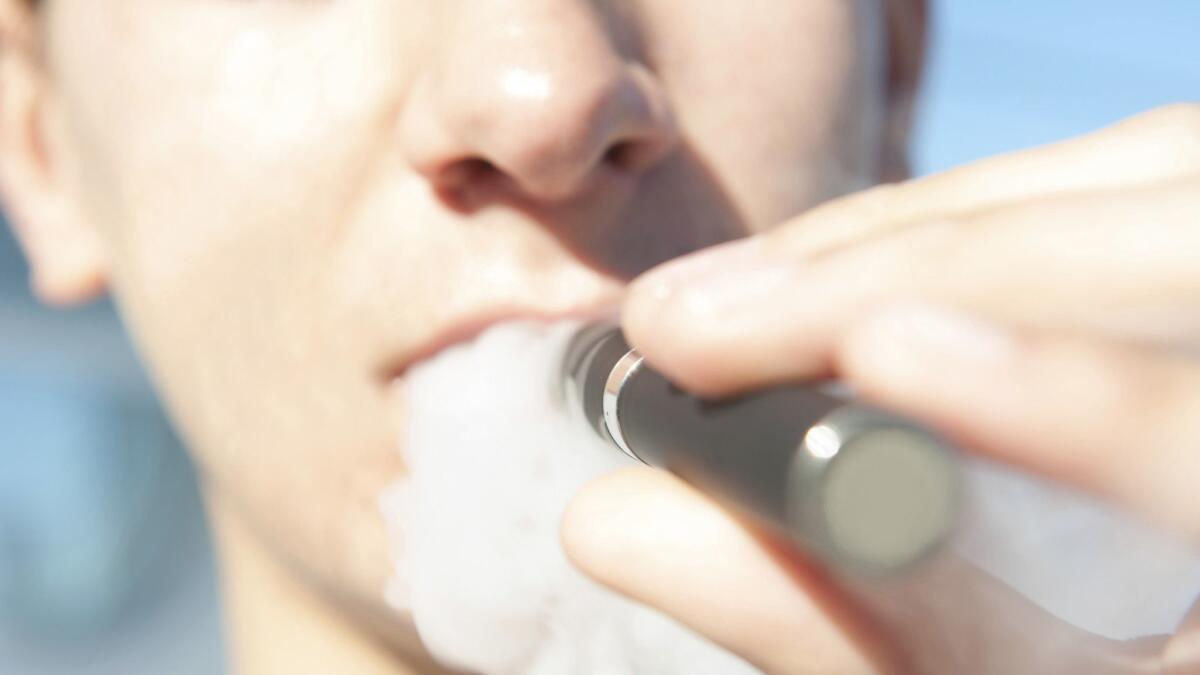Column:: It’s time to stop dithering and do something about the teen vaping epidemic

There have been some positive developments regarding the nation’s teenagers recently. Teens’ overall use of tobacco, alcohol, opioids and illicit drugs has declined significantly, in some cases to the lowest levels in a prominent national survey’s history.
However, that good news is tempered by one alarming trend: The rate of vaping is soaring.
In one finding released late last year by the National Institute on Drug Abuse, which is part of the National Institutes of Health, 37.3% of high school seniors reported having vaped within the previous 12 months. That’s a stunning increase from the 27.8% tally just one year earlier.
More than 1.3 million high school students started vaping nicotine in the last year, study says »
The survey found that vaping nicotine specifically in the month prior to the survey nearly doubled among 12th-graders, from 11% to 20.19%, while more than 10% of eighth-grade students said they had vaped nicotine within the year.
And that’s just what the teens themselves reported. Bear in mind that health officials find that some kids aren’t even aware that they are vaping nicotine, believing instead that they are merely inhaling flavored vapor from the heated liquid, or “juice,” inside their devices.
E-cigarettes, as the vaping devices are also known, first emerged in the U.S. around 2007, and were touted largely as less risky alternative for smokers to wean themselves from the deadly cigarette habit. But it wasn’t long before their use by young people began skyrocketing, and since 2014 they have been the most commonly used tobacco product among youth.
Kids are getting hooked at frighteningly young ages. My personal wake-up call came when I saw a boy who looked to be no older than 14 breeze past me on a skateboard in my Newport Beach neighborhood. I noticed one hand cupped at his mouth, then the tell-tale vapor cloud trailing in his wake.
Seeing teen vaping as an addiction, schools move toward treatment model »
Like many kids, he might have been seduced in part by the widely disseminated fiction that vaping isn’t harmful.
The subject even got the “South Park” treatment, in an episode of the long-running animated show last year that depicted some of the fourth-grade characters selling vaping goods to kindergartners.
The Centers for Disease Control and Prevention has issued blunt warnings about vapes. They are unsafe for kids, teens and young adults. Most contain nicotine, which is highly addictive and dangerous for adolescent brain development, as well as other toxic substances. Though much more research about the effects of vaping is needed, evidence is emerging that it is also damaging to hearts and lungs.
Juul, the most popular brand by far, delivers an extremely high dose of nicotine in all its products.
Yet it’s telling that the vast majority of teens report that it’s easy for them to acquire vaping products. And manufacturers —despite being under some pressure to rein in their marketing efforts geared toward teens — have continued to be highly adept at luring in young people with enticing flavorings and easy-to-conceal devices that are often designed to look like USB flash drives.
“Teens are clearly attracted to the marketable technology and flavorings seen in vaping devices, however, it is urgent that teens understand the possible effects of vaping on overall health; the development of the teen brain; and the potential for addiction,” said Dr. Nora D. Volkow, director of NIDA.
There have been attempts by health professionals to call attention to this problem, and by some states and municipalities to curtail e-cigarette sales, but these efforts have been scattered and largely ineffective. A commitment to comprehensive solutions oftentimes feels as elusive as trying to grasp a vape cloud.
We can’t afford to continue dithering. We must work aggressively to combat the teen vaping epidemic on all fronts, including comprehensive educational programs as well as more sustained and robust efforts to regulate an exploitative industry.
Under pressure from a federal court order to speed review of thousands of vaping products on the market, the U.S. Food and Drug Administration earlier this month issued guidance for e-cigarette makers to apply for FDA authorization. In applying, the companies must show that their products “would be appropriate for the protection of the public health,” the agency said.
The move was long overdue, but it’s just a start.
Schools have also been grappling with how to respond, finding themselves with the challenge of striking the appropriate balance between discipline and prevention and treatment. We should encourage their efforts and push to ensure that school policies and programs dealing with vaping are treated with the same seriousness as other drugs and alcohol.
Parents should also educate themselves. They should learn to recognize e-cigarette paraphernalia and how to spot signs that their kids might be vaping. The surgeon general’s website has a tip sheet for parents that includes straightforward facts about e-cigarettes and many helpful suggestions about how to talk to teens about them.
Vaping by teens, as with many difficult issues, took off so rapidly that it might seem as if the problem now exceeds our ability to control it.
But as the declines in drug and alcohol use among teens shows us, it is possible to make progress with even the most intractable problems if we dedicate ourselves to a concerted, sustained, multi-faceted effort.
Patrice Apodaca is a former Los Angeles Times staff writer, and is the coauthor of “A Boy Named Courage: A Surgeon’s Memoir of Apartheid.” She lives in Newport Beach.
All the latest on Orange County from Orange County.
Get our free TimesOC newsletter.
You may occasionally receive promotional content from the Daily Pilot.




